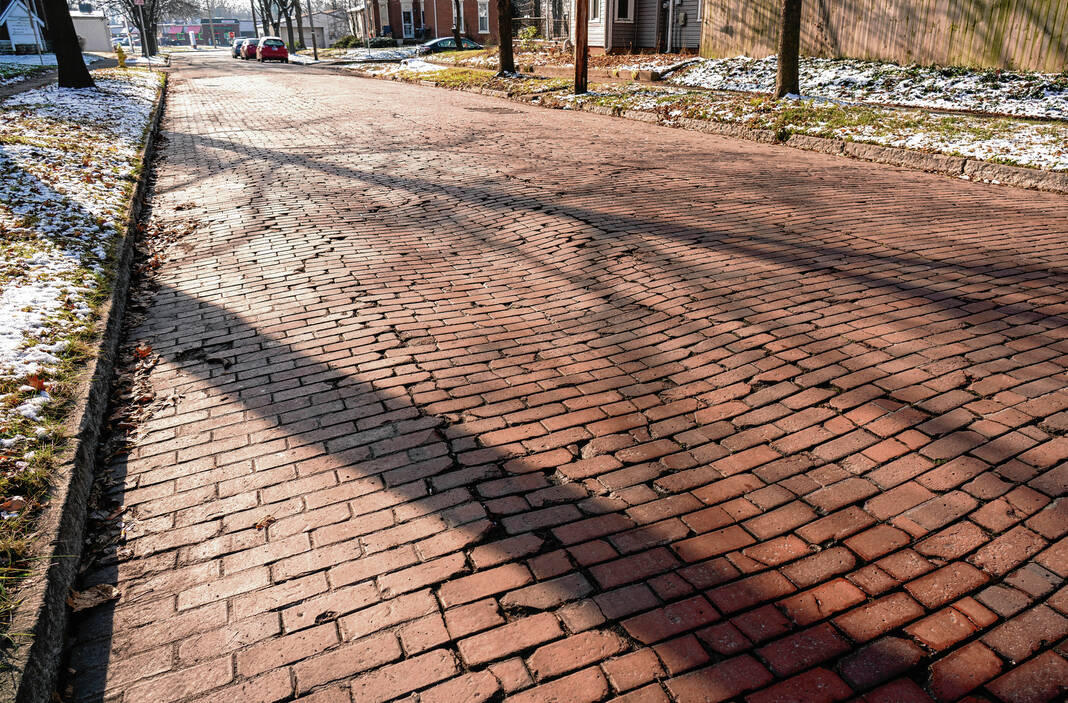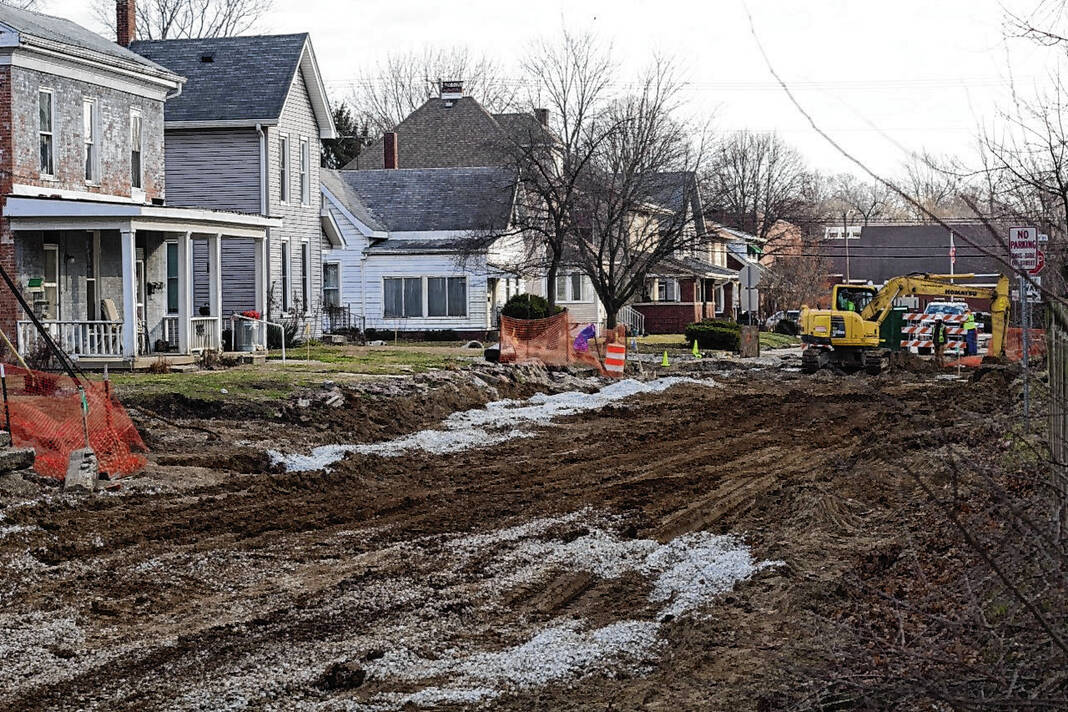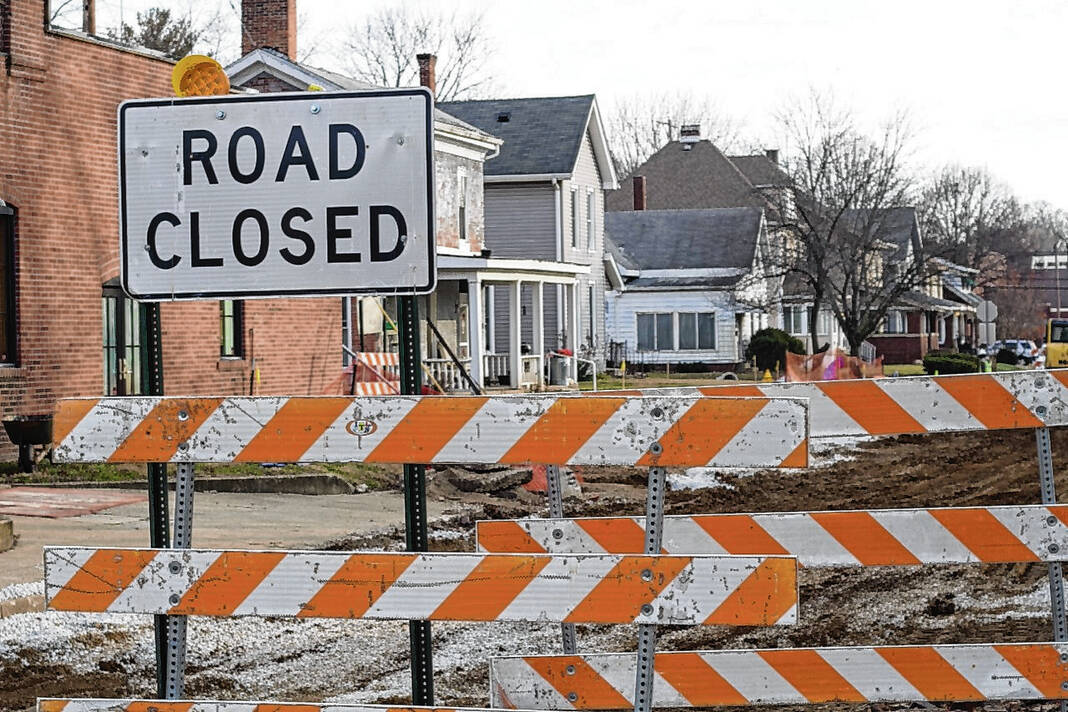
Contractors work on digging up a section of Yandes Street and its sidewalks between Madison Street and Jefferson Street in Franklin Tuesday morning. The city is spending $3.7 million to reconstruct the historic brick street and sidewalks.
Emily Ketterer | Daily Journal
Preserving Franklin’s iconic last remaining brick street is causing some headaches, but officials say it will be worth it in the end.
The $3.7 million Yandes Street project involves tearing up and replacing five blocks of brick street in a residential neighborhood northeast of downtown, plus a block of Madison Street between Yandes and Depot streets. The project also involves relocating all utility lines from the street to the sidewalk area, installing new sidewalks and installing new street lighting.
Historic-looking brick pavers are being used to create the new street.
Traffic is now diverted around the street during construction and nearby King Street is also closed to through traffic, cutting off the shortest direct path from Interstate 65 to U.S. 31.
The utility work has caused disruption in services and trash collection has been a challenge for some properties on the street, particularly for renters who live in an area of the project that is most difficult to access during construction.
Residents have complained about broken promises to keep trees on the street, a lack of communication and prompt notification for different phases of work on the project.
Many are also staying positive, even though the project hasn’t been ideal to live through.
“Yes, it is an inconvenience and not pretty to look down the street but I’m being positive. The finished project will improve our street and add value to our homes,” said resident Michelle Davis Ballard. “I don’t understand why people can’t realize this.”
About the project
Mayor Steve Barnett said Yandes Street prior to construction was definitely the worst street in Franklin, and the worst he’s seen in the county. There’s no denying it needed work, he said.
The road was in the shape it was in for several reasons: the age of the street, lack of modern drainage and the age of utility lines that were under the street. Those aging utility lines have leaked over the years and introduced water that has compromised the quality of the road, Barnett said.
The project’s goal is to fix Yandes Street “the right way” by fully reconstructing it and modernizing the street while keeping the historic character. Though the process hasn’t been easy, the area will be better for it, Barnett said.
Work on the street is part of an ongoing effort to clean up this older construction residential area that is an opportunity area for the city. The goal is to invest in the area around Yandes, Kentucky, Ohio and Young streets by fixing up the streets, alleys and ordinance violations to encourage homeowners to invest in their properties, Barnett said.
Some have already begun to do so, he said.
Communication issues
The project is a complex job that is being undertaken with federal dollars, which added layers of bureaucracy that a city street project wouldn’t normally have. These extra layers complicated the process and that’s the main reason there have been communication issues between the city, contractors and residents, Richards said.
The project is funded with $2.32 million in federal dollars allocated to the project by Indianapolis Metropolitan Planning Organization, or IMPO. Because of the funding source, the project is being managed by Indiana Department of Transportation, with involvement from the city in meetings on the project and through an outside inspector the city hired to watch over the project, said Mark Richards, Franklin city engineer. The city’s Board of Works and Public Safety is also in charge of approving any change orders for the project.
With the number of contractors involved in this project and the extra layers of bureaucracy, communication on the project has not been ideal, Richards acknowledged.
“That’s why we hire a firm to handle the inspection (and) manage the project. And we are having continuing discussions with him on making sure that they get timely information out to the residents,” Richards said. “So we recognize that there is a problem. And we are working to address it as quickly as possible.
For example, some complained about not getting a boil water notice, but that was out of the city’s hands. That’s because the work and responsibility to notify people lied with Indiana American Water and their contractor for water line relocation, Richards said.
Others have reported problems with trash pickup, but that’s not unique to only Yandes Street. The city’s trash contractor, Waste Management, has recently had equipment and staffing issues, Richards and Barnett said.
People who have issues should contact the city’s inspector for the project, Mike Hennigan of GAI Consultants. Residents in the project area have been given his contact information, Richards said.
Tree controversy
Backlash on the removal of trees on the street is the most visible communication gap.
Though it was originally promised to residents that some trees could stay during a neighborhood meeting on the project, all were removed. The trees were not expected to survive long-term due to damage to their root systems during utility installation, city officials said.
When city officials were alerted that the trees impacted by utility construction might need to be removed, an arborist came in to look at each tree. It was determined that all of the trees would need to be removed within a few years, Richards said.
Instead of going back to remove them later, it was decided that it would make more sense to take the trees out during construction and plant new ones this fall, Richards said.
Residents say they were not given notice the trees would be removed. They received a notice dated Dec. 22 stating that trees that could be saved were marked, but residents say that didn’t happen. One day, contractors just began cutting them down — now they’re all gone, residents said.
Barnett, a self-described “tree guy,” said he questioned from the beginning the engineering firm’s promise to residents. City officials knew from the beginning that certain trees would be removed because some were already dead or dying. They also knew, from experience, that cutting into the root system of trees in the right of way could effectively kill many of the trees, Barnett said.
The city’s goal was always to save any trees if possible, but there shouldn’t have been a promise made when there was uncertainty, Barnett said.
“I personally feel really bad about those trees being taken down. The main reason is because the engineering firm told us that those trees could stay,” Barnett said. “And I think it would have been better off if we could have told the residents we can’t save these trees … Maybe we had been misled a little bit on saving the trees, which misled the residents. And that’s who I care about most — the residents.”
The trees are being replaced on a 2:1 ratio, Barnett said.
Trees might not be planted in same spot they were removed from, Richards said. The best placement for the health of the tree will be determined after construction is complete in the fall, he said.
On schedule
So far, the project is on schedule and expected to be substantially complete by November, if not sooner, Richards said.
Though there have been some unforeseen issues, such as an issue bringing a new utility line online, the project is still on schedule and could even be completed a month early if the rest of the project goes smoothly, he said.
Yandes Street is likely the last major road reconstruction project the city will undertake in the coming years, aside from several planned roundabouts, Barnett said.
This doesn’t count the major reconstruction that INDOT has planned on U.S. 31 beginning in 2024.
Editor’s Note: A previous version of this story said the street would be paved using old bricks, however, that was eliminated from the project to cut costs, city officials said. Instead, all new bricks that have a historic look are being used.











